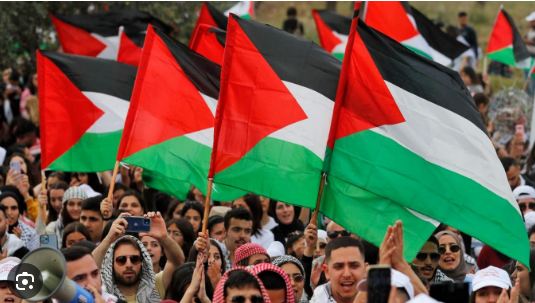RAMALLAH, MAY 14: Ola Awad, President of the Palestinian Central Bureau of Statistics (PCBS), via figures, historical and current data, reviewed the geographical, demographical and economic situation of the Palestinian People on the 75th Annual Commemoration of the Palestinian Nakba, which occur takes place on May, 15th; and those figures and data run as the following:
The Nakba: Ethnic cleansing, displacement of Palestinians and settler colonialism
Nakba in Palestine describes a process of ethnic cleansing in which an unarmed native nation was destroyed and its population displaced systematically to be replaced by Jewish occupiers from all over the world. The Nakba resulted in the displacement 957 thousands Palestinians out of the 1.4 million Palestinians who were living in historical Palestine in 1948 in 1,300 villages and towns. The majority of the displaced Palestinians ended up in neighboring Arab countries, in the West Bank and Gaza Strip and other countries in the world. Furthermore, thousands of Palestinians – who stayed in the land controlled by Israeli occupation in 1948 – were driven out of their homes and lands which were seized.
According to the historical documentary evidence, Israeli Occupation controlled 774 towns and villages and destroyed 531 Palestinian towns and villages during the Nakba. The atrocities of Zionist forces also included more than 51 massacres in which more than 15 thousand Palestinians were martyred.
The Demographic Reality: Palestinian population has doubled about 10 times since the Nakba, 1948
The population of Palestine in 1914 was around 690 thousand; of whom only 8% were Jewish. In 1948, the number of Palestinians in Palestine exceeded 2 million; 31.5% of them were Jews. Between 1932 and 1939, the largest number of Jewish immigrants to Palestine reached 225 thousand Jews. Between 1940 and 1947, more than 93 thousand Jews poured into Palestine. Thus, Palestine received around 318 thousand Jews between 1932 and 1947 and more than 3.3 million from 1948 to 2022.
Despite the displacement of more than one million Palestinians in 1948, and the displacement of more than 200 thousand Palestinians (majority of them to Jordan) after the 1967 war, the Palestinian world population was 14 million by the end of 2022, which means that the number of Palestinians in the world has doubled about 10 times since the Nakba, and more than half of them lived in historical Palestine by the end of 2022. Accordingly, their number reached 7 million (1.7 million in the occupied territories in 1948). Population estimates indicated that the number of population by the end of 2022 in the West Bank, including Jerusalem, was 3.2 million and around 2.2 million in the Gaza Strip. As for the population of Jerusalem Governorate, it was about 487 thousand; approximately 65% of which (about 314 thousand) lived in those parts of Jerusalem which were annexed by Israeli occupation in 1967 (J1). Data showed that Palestinians represented 50.1% of the population living in historical Palestine, while Jews constituted 49.9% by the end of 2022. Israeli occupation continues its control over 85% of the area of historical Palestine, which amounts to 27 thousand square kilometers (km2).
Percentage of Palestinians and Jews in Historical Palestine in Various Years
Palestinian Refugees Status
In December 2020, the records of the United Nations Relief and Works Agency (UNRWA) showed that the total number of Palestinian refugees was around 6.4 million of them around two million in West Bank and Gaza Strip, 28.4% of whom live in 58 camps (10 in Jordan, 9 in Syria, 12 in Lebanon, 19 in the West Bank and 8 in Gaza Strip). Those estimates, however, indicated the minimum number of refugees, as many of them are not registered. This number does not include the Palestinians displaced in the period from 1949 till the Six-Day war in June 1967. The UNRWA definition of refugees does not cover Palestinians who migrated or those who were displaced after 1967 because of the war and who were not registered refugees.
Gaza Strip has one of the highest population densities in the world
The population density in the State of Palestine by the end of 2022 was 899 individuals per square kilometer (km2): 569 individuals/km2 in the West Bank and 6,019 individuals/km2 in Gaza Strip, noting that 66% of the total population of Gaza Strip are refugees. The flux of refugees turned Gaza Strip into one of the highest population densities in the world. Despite the small area of Gaza Strip, Israeli occupation set up a buffer zone over more than 1,500 meters along the Eastern border of Gaza Strip. Consequently, Israeli occupation controls about 24% of the total area of Gaza Strip (365 km2). Also, the continuous siege on Gaza Strip, which is one of the most densely populated areas in the world, led to a sharp rise in unemployment in Gaza Strip. Hence, the unemployment rate reached 47%, around 69% of the youth aged 15-24 years are unemployed by the end of 2021. The siege also shook the economy of Gaza Strip and turned over half of its population into poor (53%).
More than 100 Thousand Martyrs since the Nakba, 1948
The number of Palestinian and Arab martyrs killed since the Nakba in 1948 and until this day (inside and outside Palestine) reached about 100 thousand martyrs[1]. Moreover, the number of martyrs killed in Al-Aqsa Intifada between September 29th 2000 until December 31st 2022 was 11,540. It is said that the bloodiest year was 2014 with 2,240 Palestinian martyrs, 2,181 of them were from Gaza Strip during the war on Gaza. During 2022, the number of Palestinian martyrs reached 231, 56 of whom were children and 17 women. While the number of wounded Palestinians reached about 10,000 in 2022.
More than Million Detention Cases since 1967
25 prisoners have spent more than a quarter of a century in occupation prisons
By the end of April 2023, there were 4,900 Palestinian detainees in the Israeli occupation prisons, 160 of them are children and 31 women. As for the number of arrests, it reached 7,000 during the year 2022, including 882 children and 172 women, while the number of administrative detention orders against citizens who were not charged with any charges reached 850. Data also indicates that there are 554 prisoners serving life sentences, and 1,000 administrative detainees. Moreover, data indicates that Israel is detaining more than 700 sick prisoners and four prisoners of Parliament in the Legislative Council, in addition to the presence of 23 prisoners who were arrested before the Oslo Accords in 1993 and they are still languishing in Israeli prisons.
Data clearly indicates that the number of martyrs among the prisoners has reached 237 prisoners since 1967 due to torture or willful killing after arrest or medical negligence against the prisoners. Data also indicates that the martyrdom of 114 prisoners since September 2000, where the year 2007 witnessed the highest percentage of prisoners’ martyrdom inside Israeli prisons as seven prisoners were killed, five of them died as a result of medical negligence.
Israeli Occupation: Continuous Expansion of Settlements
By the end of 2021, there were 483 Israeli occupation sites and military bases in the West Bank, including 151 settlements and 25 inhabited outposts that considered as neighborhoods following established settlements, in addition to 163 settlement outposts, and 144 classified as other sites (industrial, tourists, service areas and Israeli army bases). As for the number of settlers in the West Bank, it reached 719,452 settlers by the end of 2021. Thus, data shows that around 45.4% of settlers live in Jerusalem governorate, where their number reached about 326,523 settlers; out of which 239,951 settlers live in East Jerusalem (J1) “including those parts of Jerusalem which were annexed by Israeli occupation in 1967”. Followed by Ramallah and Al-Bireh governorate with 143,311 settlers, 95,279 settlers in Bethlehem governorate, and 50,067 settlers in Salfit governorate. While Tubas & the northern Jordan Valley are the lowest governorates in terms of the number of settlers with 2,629 settlers. The ratio of settlers to Palestinians in the West Bank is about 23 settlers for every 100 Palestinians, while the highest is in Jerusalem governorate with about 69 settlers for every 100 Palestinians. The year 2022 witnessed a significant increase in the pace of building and expanding Israeli settlements, as the occupation authorities approved about 83 project plans to build more than 22 thousand units throughout the West Bank, including Jerusalem.
Continuous Confiscation of Land
Israeli occupation used the land classification according to the Oslo Accords (A, B and C) to tighten their control over the Palestinian land, especially in areas classified as (C) which are under the full control of the Israeli occupation in terms of security, planning and construction, where 76% of the total area classified as (C) is directly exploited by the Israeli occupation; settlements regional councils are controlling 63% of it. While the area of authority regions in the Israeli settlements in the West Bank (Including closed regions allocated for expanding those settlements) is about 542 km2 as it is by the end of 2021; representing about 10% of the total area of the West Bank. Whereas the confiscated areas for the purposes of military bases and military training locations represent about 18% of the West Bank area, in addition to the Annexation and Expansion Wall that has isolated more than 10% of the area of the West Bank. Consequently, more than 219 Palestinian localities were badly affected by the establishment of the Annexation and Expansion Wall. In addition, and since 1967, Israeli occupation authorities have confiscated about 353 thousand dunums of Palestinian lands and classified them as natural reserves in preparation for their seizure.
Jerusalem: Intensive and Systematic Judaization
As part of the policy of deportation and replacement, Israeli occupation authorities are taking accelerated judaizing measures to Jerusalem in order to obliterate the Islamic and Christiane landmarks and displace Palestinians from the city of Jerusalem, to replace them with Israelis from all over the world. During 2022, the Israeli occupation authorities approved about 70 planning project to construct of more than 10 thousand settlement units in Jerusalem, at a time that Israeli occupation authorities demolished more than 258 buildings and issued demolition orders for more than 220 Palestinian buildings, including 100 residential buildings in Al-Bustan neighborhood as part of the policy of mass demolition, which leads to the displacement of 1,550 people, most of them children and women. In addition, the frequency of targeting Palestinians increased, as 19 Jerusalemites were killed and about 2,486 Palestinians were wounded by Israeli occupation bullets during 2022. The number of arrest cases increased by 22%, which the occupation launched in Jerusalem governorate during 2022, as the number of arrest cases reached about 3,504 compared to about 2,879 case in 2021.
More than 8,700 attacks by Israeli occupation force and settlers during 2022
In 2022, settlers, under the protection of Israeli occupation force, carried out about 8,724 attacks against Palestinian citizens and their property. These attacks were distributed as 1,515 attacks on property and religious places, 362 attacks on lands and natural resources, and 6,847 attacks on Palestinian individuals. On the other hand, the year 2022 witnessed an attempt by settler groups on 63 occasions to establish outposts, most notably the attempt of the right-wing Nahla movement to establish more than 10 outposts on 7/20/2022. The occupation forces and settlers also launched 223 confiscation operations of about 294 Palestinian property, including 48 agricultural tractors, and 53 cars for Palestinian citizens. These attacks also caused the uprooting, damage and destruction of 10,291 olive trees.
Israeli occupation authorities carried out 378 demolitions that affected 953 facilities in the West Bank during 2022
The policy of the occupation forces did not stop demolishing Palestinian-owned buildings and the resulting displacement of residents from their homes throughout the West Bank, as the Office for the Coordination of Humanitarian Affairs in the Occupied Territories (OCHA) documented since 2009 that the occupation forces destroyed 9,353 homes or facilities since 2009. 2009, including 1,639 facilities funded by donors, which led to the displacement of 13,641 citizens. The demolitions were 19% in East Jerusalem, 79% in areas classified (C), and about 2% of the demolitions were in areas classified (A) and (B). OCHA documented About 953 facilities were demolished during 2022, including 140 facilities funded by donors, which led to the displacement of 1,031 citizens and affected 28,446 citizens, of which inhabited and uninhabited agricultural and residential facilities represented about 70%. During 2022, the occupation authorities carried out 378 demolitions affected 953 facilities in the West Bank and Jerusalem. Most of the demolitions were concentrated in the Jerusalem governorate, with 118 demolitions; represent 31%, leaving 178 demolished buildings in Jerusalem city, of which 98 were self-demolition operations. Israeli occupation authorities also issued 1,220 demolition notices, of which about 33% were in Hebron Governorate, 18% in Bethlehem Governorate, and 9% in Ramallah and Al-Bireh Governorate, in addition to the destruction of many infrastructure sites that serve the Palestinians, including roads, water and sanitation networks, and recreational places …etc.
The amount of water consumed per capita in Palestine is less than the minimum according to international recommendations
The daily allocation per capita from consumed water for domestic purposes is 86.3 liter/capita/day in Palestine: 89.0 (l/c/d) in the West Bank, while it is 82.7 (l/c/d) in Gaza Strip in 2021. By taking into account the increase of population, the high percentage of water pollution in Gaza Strip and calculating the quantities of water suitable for human use from the available quantities, the per capita share of fresh water is only 21.3 liters per day in Gaza Stip. When comparing this rate with the Israeli daily allocation per capita, we note that the Israeli daily allocation per capita is more than three times that of the Palestinian individual, about 300 liters per day, and this rate doubles for Israeli settlers to more than 7 times than Palestinian per capita consumption.
Israeli occupation control over the water of Jordan River and Dead Sea
Data showed that the percentage of abstracted surface and groundwater from available water during 2021 was high with an average of 76.4%. It should be noted that Palestinians have been denied, by Israeli occupation, to access and abstract water from the Jordan River since 1967, which is estimated of about 250 MCM. On the other hand, the quantity of water pumped from the Palestinian wells in the West Bank in 2021 was 105.3 MCM from Eastern Aquifer, Western Aquifer and North-Eastern Aquifer. The amount of water abstracted from the coastal aquifer was 192.5 million cubic meters (MCM) in Gaza Strip in 2021. However, this quantity is obtained via unsafe pumping that jeopardizes the sustainability of the source, as the basin sustainable yield should not exceed 50-60 MCM a year, where the groundwater level in the coastal aquifer reached 19 meters below sea level leading to the depletion of groundwater reserves, this led to that fact that 97% of the water pumped from the coastal aquifer in Gaza Strip does not meet the water quality standards of the World Health Organization.

















